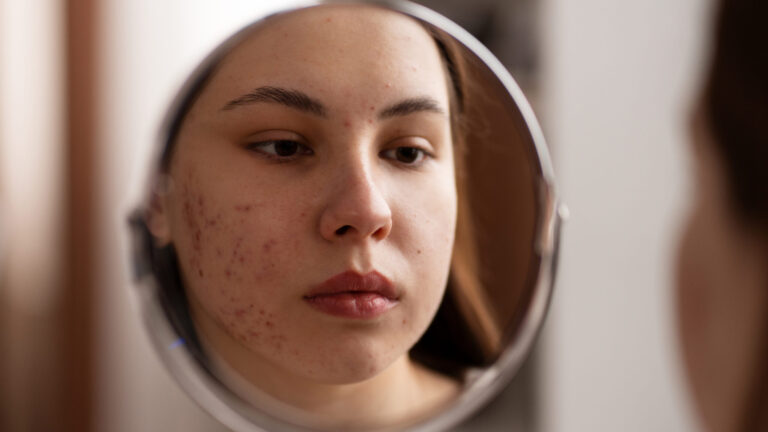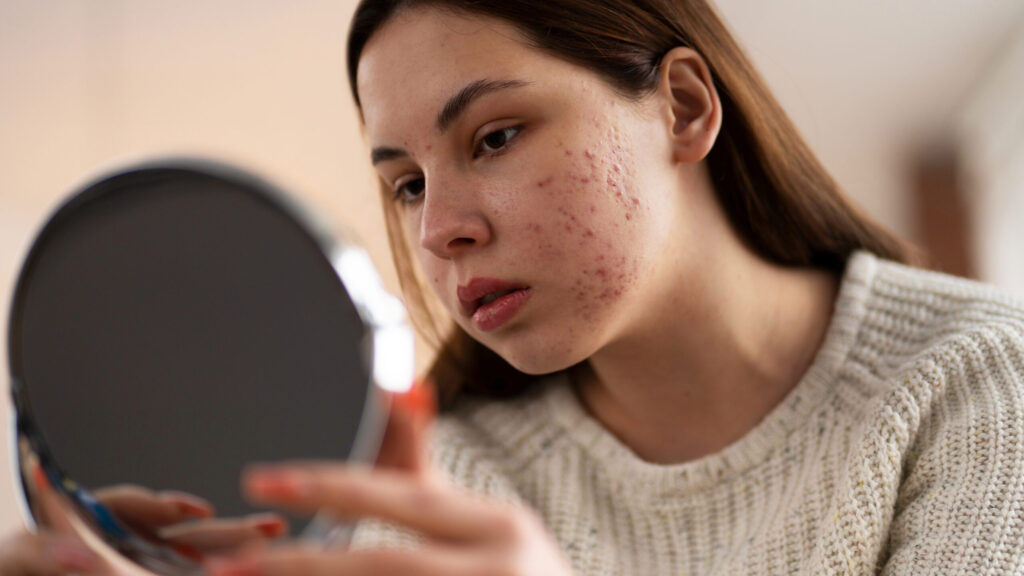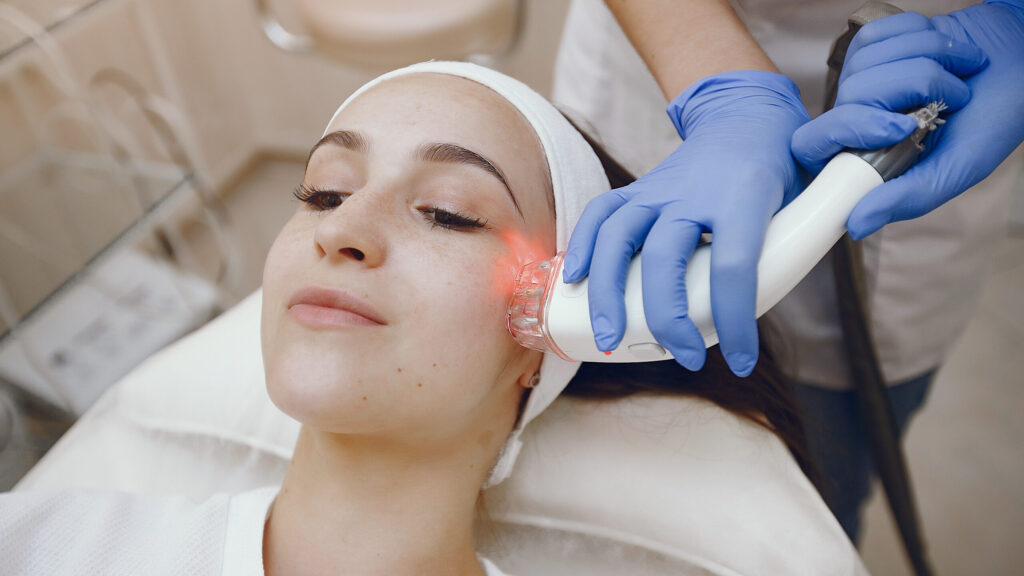Acne scars are a prevalent worry among those who have had acne breakouts since they can have a long-lasting effect on one’s confidence and self-esteem. Among the many skincare procedures available, microdermabrasion has drawn a lot of interest for its potential to remove these difficult-to-remove scars. In this article, we’ll examine the efficiency of microdermabrasion in getting rid of acne scars and discuss its advantages and drawbacks.

Understanding the nature of acne scars before getting into the mechanics of microdermabrasion is essential. Inflammatory acne lesions, such as papules, pustules, and cysts, can cause collagen fiber destruction in the skin, which can lead to acne scarring. These scars may appear as an ice pick, boxcar, rolling, or hypertrophic scar, among other types of scars.
What is Microdermabrasion?
A device is used in the non-invasive cosmetic process of microdermabrasion to gently exfoliate the skin’s outer layer, eliminating dead skin cells and accelerating skin cell turnover. Usually, it entails applying tiny crystals or a wand with a diamond tip to the skin’s surface, then suctioning the exfoliated material away. The process seeks to enhance the appearance, tone, and texture of the skin.
How Does Microdermabrasion Work on Acne Scars?
The stratum corneum, the skin’s outermost layer, is delicately abraded during microdermabrasion. The technique accelerates cell turnover and encourages the creation of new, healthy skin cells by eliminating this layer. Acne scars are made less noticeable over time, and the skin’s texture is smoothed throughout the exfoliation process, which aids in their fading. Additionally, it promotes the formation of collagen, which, over time, can make scars look better overall.
Caci Clinic says that the good news is that treating acne scarring with microdermabrasion can significantly lessen its appearance. Microdermabrasion physically removes the top layer of skin to promote cell turnover and boost collagen formation, which helps to lessen the appearance of acne scarring.
Types of Microdermabrasion Techniques:
Crystal microdermabrasion and diamond-tip microdermabrasion are the two most popular types of microdermabrasion procedures.
- Microdermabrasion with crystals: In this method, a handheld instrument is used to spray small crystals onto the skin’s surface. These crystals are commonly sodium bicarbonate or aluminum oxide. While a Hoover system simultaneously removes the exfoliated particles, the crystals abrade the skin.
- Diamond-Tip Microdermabrasion: This method softly buffs the skin’s surface using a wand that has a diamond tip. A Hoover suction removes the dead skin cells after the skin is exfoliated using a diamond tip.
Both methods produce comparable results, and the choice between them frequently comes down to the practitioner’s own preferences and the individual’s particular needs.
The Potential of Microdermabrasion for Acne Scars:
To cure acne scars, particularly those with superficial scarring and uneven skin tone, micro-dermabrasion is regarded as a light procedure. By encouraging the growth of new skin and enhancing the production of collagen, it can aid in minimizing the appearance of scars. The process of exfoliation aids in removing the skin’s damaged upper layer to expose younger, healthier skin underneath.
- Microdermabrasion advantages: Skin with an easier texture Micro-dermabrasion helps to exfoliate the skin, which helps to lessen the unevenness brought on by acne scars and produces a smoother skin texture.
- Improved Pigmentation: In some circumstances, micro-dermabrasion can help reduce the appearance of dark spots by fading post-inflammatory hyperpigmentation (PIH) brought on by acne.
- Increased Penetration of Topical Therapies: Topical therapies, such as serums or lotions, can penetrate the skin more effectively thanks to micro-dermabrasion, making them more effective at treating acne scars.
- Minimal Downtime: Unlike more invasive procedures, microdermabrasion frequently involves no downtime, allowing patients to get back to their regular routines right away.
- The number of sessions and maintenance: Micro-dermabrasion is a progressive procedure, and for best results, several treatments are usually necessary. The number of sessions required can vary based on the person’s response to therapy, the severity of the acne scars, and their skin type. A series of 5 to 10 sessions, spaced roughly 2 to 4 weeks apart, is often advised.

Additional informantion:
To maintain the outcomes after the initial treatment series, maintenance sessions could be suggested. Depending on the needs of the patient, maintenance treatments might be planned every one to three months.
- Microdermabrasion in Combination with Other Therapies: For better outcomes, micro-dermabrasion can be used with other therapies for acne scars. To treat deeper scars, it is frequently combined with chemical peels or laser resurfacing. Based on a patient’s unique needs, a dermatologist or skincare expert may advise combining treatments to provide a more thorough approach to scar reduction.
- Post-Treatment Care: To maximize benefits and reduce any potential side effects, it is crucial to adhere to the recommended post-treatment care after a micro-dermabrasion session. Typically, this entails avoiding exposure to the sun, using a mild cleanser and moisturizer, and covering the newly exposed skin with broad-spectrum sunscreen to protect it. To help the skin repair and recover correctly following the treatment, it is also advised to delay using abrasive skincare products or exfoliants.
Limitations and Considerations:
While there are some advantages to micro-dermabrasion for healing acne scars, it’s crucial to remember that not everyone or all types of acne scars may respond well to it. If you want to see a major improvement in deep or severe scars, you may need more intense procedures like laser resurfacing or chemical peels.
Additionally, controlling expectations is crucial. Multiple sessions are typically necessary to see obvious benefits from micro-dermabrasion because it is a progressive procedure. Results may differ based on personal factors such as skin type, scar severity, and general skin health.
Additionally, people with sensitive skin or active acne should use caution because micro-dermabrasion may make their issues worse. It is always advised to seek the advice of a dermatologist or skincare expert to choose the best course of action.

To conclude...
When it comes to treating superficial acne scars and enhancing the general texture of the skin, micro-dermabrasion can be a useful technique. While it might not eliminate deep or severe scars, it can greatly reduce their visibility and give the skin a smoother appearance. As with any skincare procedure, it’s critical to speak with a trained expert to determine your unique requirements and create an effective treatment strategy. Setting realistic expectations and being aware of micro-dermabrasion’s possibilities will help you get closer to having smoother, more vibrant skin.
Are Micro-needling Results Permanent For Acne Scars? Read this blog to find out more.
Wondering if facials, especially hydrafacials, would help with acne scars? Read the blog, Does Hydrafacial Help With Acne Scars, to find out more!

